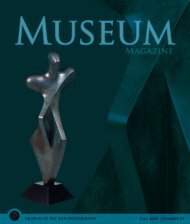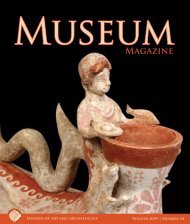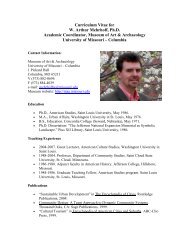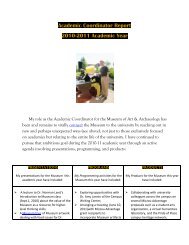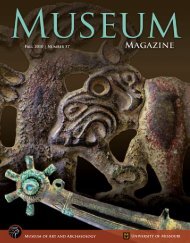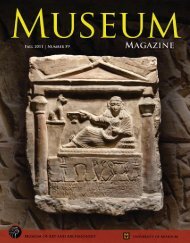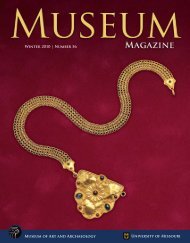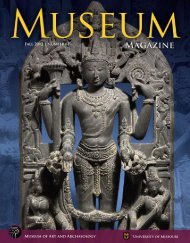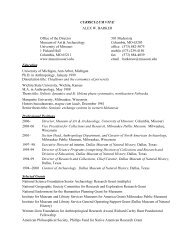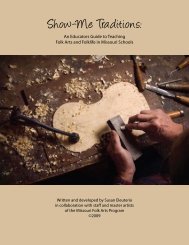Winter 2011 - Museum of Art and Archaeology - University of Missouri
Winter 2011 - Museum of Art and Archaeology - University of Missouri
Winter 2011 - Museum of Art and Archaeology - University of Missouri
- No tags were found...
You also want an ePaper? Increase the reach of your titles
YUMPU automatically turns print PDFs into web optimized ePapers that Google loves.
From the DirectorThis past semester I’ve been teaching a graduate seminar in museum studies.As their final project the students designed exhibitions, presenting them (<strong>and</strong>defending them) to the rest <strong>of</strong> the class. I placed no major constraints on topicsor design, except that they needed to be able to justify the choices they madein terms <strong>of</strong> the technical constraints on particular kinds <strong>of</strong> objects, the needs <strong>of</strong>audiences, <strong>and</strong> the didactical limitations <strong>of</strong> exhibition labels. I think—I hope—they learned a lot. I know I did.The students addressed a wide range <strong>of</strong> topics, from the ambiguity <strong>of</strong> gender <strong>and</strong> identity in the works <strong>of</strong> contemporaryartist Cindy Sherman to the effects <strong>of</strong> pesticide <strong>and</strong> prospects for controlling pests using natural means, <strong>and</strong> from cuisine inancient Rome to a powerful <strong>and</strong> disturbing treatment <strong>of</strong> racism <strong>and</strong> lynching. All <strong>of</strong> them had areas <strong>of</strong> special strength, <strong>and</strong>each <strong>of</strong> them had one or more “aha!” moments <strong>of</strong> resonance <strong>and</strong> wonder.Stephen Greenblatt—one <strong>of</strong> my favorite authors—argues that this is the proper role <strong>of</strong> museums; we are purveyors <strong>of</strong>resonance <strong>and</strong> wonder, <strong>and</strong> these are the currencies by which value in museums is measured. “Resonance,” he argues, is theability for an exhibition to engage us, to find a way to connect with us at an immediate <strong>and</strong> human level. It’s the commonground that makes an exhibition relevant to us as individuals or communities. “Wonder” is the magical ability <strong>of</strong> exhibitionsto transport us out <strong>of</strong> our time <strong>and</strong> place to appreciate new ways <strong>of</strong> seeing, to experience ancient worlds long faded to dust,or to imagine new worlds not yet born.Over the next year the <strong>Museum</strong> <strong>of</strong> <strong>Art</strong> <strong>and</strong> <strong>Archaeology</strong> will mount a series <strong>of</strong> exhibitions that <strong>of</strong>fer the chance to travel t<strong>of</strong>araway or long past worlds, to see the world through other eyes, <strong>and</strong> to return to our own with a fresh perspective—inother words, exhibitions <strong>of</strong> resonance <strong>and</strong> wonder. We begin with A Midwestern View: The <strong>Art</strong>ists <strong>of</strong> the Ste. Genevieve<strong>Art</strong> Colony, which examines an influential but now little-known art colony in southeastern <strong>Missouri</strong>. Next is Ran In-Ting’sWatercolors: East <strong>and</strong> West Mix in Images <strong>of</strong> Rural Taiwan, an exhibition <strong>of</strong> watercolors by one <strong>of</strong> the most acclaimedTaiwanese artists <strong>of</strong> the 20th century. And we follow that exhibition with an examination <strong>of</strong> commerce in the ancient world.The Mediterranean Melting Pot: Commerce <strong>and</strong> Cultural Exchange in Antiquity traces the far-flung trade connections thatmade the economics <strong>of</strong> the Greco-Roman world pr<strong>of</strong>oundly international in both scope <strong>and</strong> character.We’ll also be <strong>of</strong>fering a smaller numismatic exhibition curated by collections specialist Kenyon Reed. CIA: Counterfeits,Imitations <strong>and</strong> Alterations <strong>of</strong> Ancient Coins looks beyond more traditional presentations <strong>of</strong> ancient coins <strong>and</strong> examines theways they were faked, altered, <strong>and</strong> manipulated in antiquity. This exhibition <strong>and</strong> Benton Kidd’s Mediterranean Melting Pot inFall <strong>2011</strong> bring into sharper focus similarities between the ancient world <strong>and</strong> our own. And along the way we’ll also mount asmall exhibition celebrating the life <strong>of</strong> George Caleb Bingham, examining themes <strong>of</strong> sentiment <strong>and</strong> loss in his portraits.We have ourselves experienced losses that leave all <strong>of</strong> us saddened. Herb Brown, husb<strong>and</strong> <strong>of</strong> the late Betty Brown <strong>and</strong> afamiliar face at <strong>Museum</strong> functions, passed away earlier this year. And Jean McCartney, an active <strong>Museum</strong> docent <strong>and</strong> regularpatron <strong>of</strong> all <strong>of</strong> the arts institutions <strong>of</strong> the area, died suddenly in December. Both will be very deeply missed; both remind usto hold our friends <strong>and</strong> family—another source <strong>of</strong> resonance <strong>and</strong> wonder—all the more tightly.See you at the <strong>Museum</strong>!Alex W. BarkerDirector



